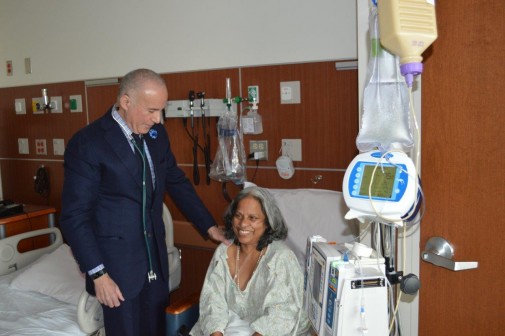World Cancer Day: A look into the life of an oncologist
February 4 is World Cancer Day. The goal of this day is to raise awareness of cancer and to encourage its prevention, detection, and treatment. The primary goal of the World Cancer Day is to significantly reduce illness and death caused by cancer by 2020. In honor of this day, Dr. Jacob Bitran has provided a real-life account of what it is like to treat patients that are battling cancer on a daily basis.
I’m a hematology oncologist, which means I treat patients suffering from blood diseases such as leukemia, lymphoma and sickle-cell disease. I’ve been doing this for 38 years and treating patients that are dealing with life-threatening illnesses can be the most rewarding job in the world and at times it can also be the most terrifying job, often in the same day.
The worst days of my life are when I look into the eyes of a patient and tell them that there is nothing more I can do, and that they should start saying their goodbyes. Those are the days that I hate what I do. It’s difficult seeing the fear in their eyes, and the tears that follow. Those days will always haunt me and they are emotionally draining.
Before getting to that point, I become fixated on a solution. Each case I work through every possible outcome and think about if there is something we haven’t tried or something we haven’t thought of. Try as we may, we aren’t always able to sway the hands of destiny.
So what keeps me going you might ask? I think back to my very first patient and the many others just like him.
It was 1977, he was a young man, only 20 years old, with a watermelon sized mass causing an obstruction within his intestine. The attending surgeon removed a majority of the obstruction, closed him up quickly and advised the family that the outlook was bleak. I was consulted because I was the only one in my group willing to see him. I was also young, had just completed my training and had to earn my keep. I sat with the pathologist, who was one of the best in the Chicagoland area and reviewed the images.
The tumor was ugly, bizarre in its appearance, and highly aggressive. The pathologist told me she was going to sign this case out as undifferentiated malignancy of undetermined primary origin. This meant it was incredibly complex, and for all intended purposes, untreatable. Since there was little protocol for this type of tumor, I decided I would treat this patient for the types of cancer that were potentially treatable based on the medicine at the time. Unfortunately back then, we couldn’t do anything to treat melanoma or sarcoma.
I explained my rationale to the young man and his family, the attending surgeon who was older and wiser informed them he mostly likely only had 4-6 months to live. They quickly agreed to my plan and we embarked on a course of therapy that offered a glimmer of hope.
He was treated with a chemotherapy regimen that included a cocktail of three different types of cancer fighting drugs. He was treated for 9 months (remember he was only expected to live 4-6) and unlike the initial scan that lit up the entire peritoneal space, the scan at the conclusion of therapy was clean. I couldn’t believe it! He cried, his family cried, and I was beaming. I had given him his life back. I reflected back on that day as one of the best in my professional life. It was an incredible high and I was hooked.
The patient went on to become an FBI agent and, miraculously, was able to have children. We’ve kept in touch and I continue to live for the days when I can tell a patient they are cured and I get to watch them go back to living a normal life.
As a hematology/oncology physician, this is my life, incredible highs and the lowest of lows. Cancer for me is a potentially curable illness and my job is to achieve the best possible outcomes. Yet, when we cannot cure the disease, my patients and I work together to create the best quality of life for as long as possible and I will not give up in the fight, because this is the job I was born to do.


















